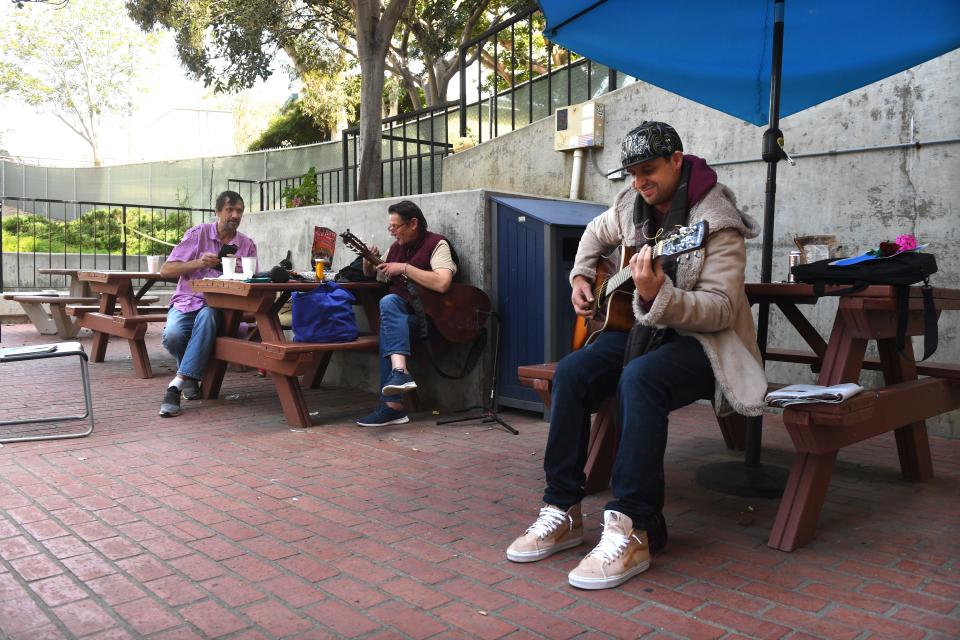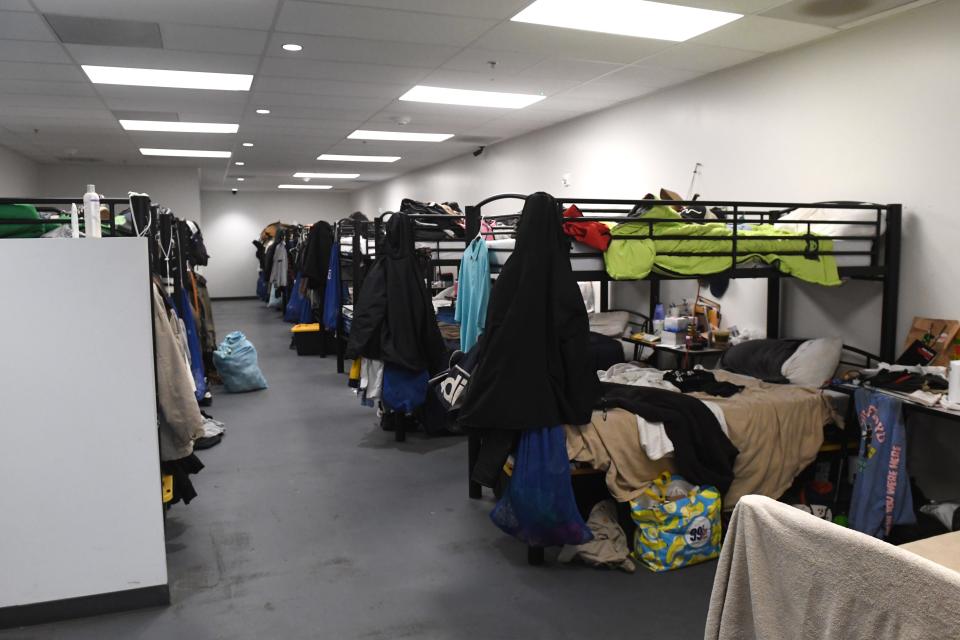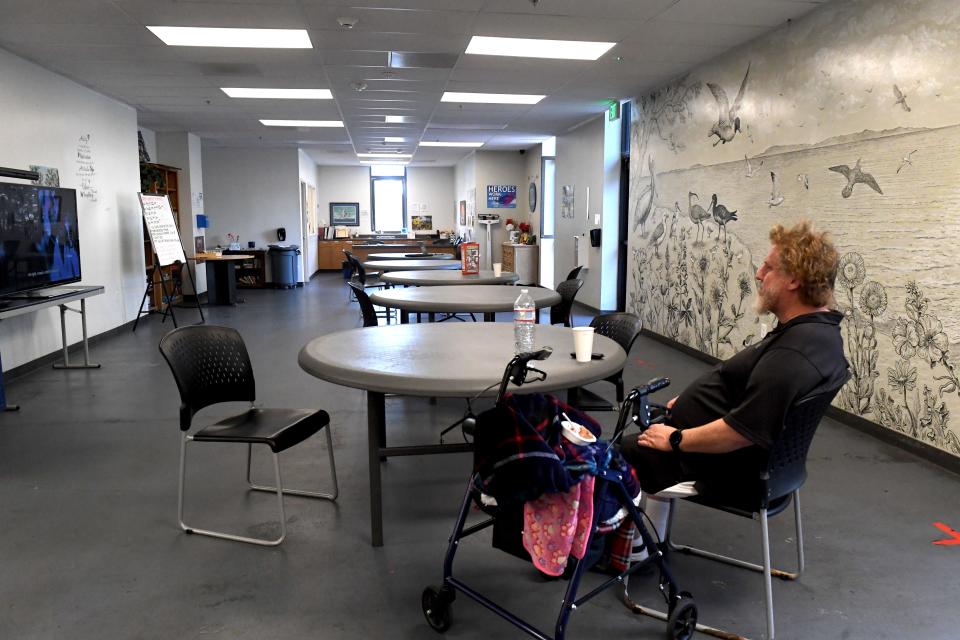Ventura County has more homeless shelter beds than ever. It's still not enough
Daisy Rodriguez was living in a tent in a dirt parking lot in Fillmore in the spring of 2022, after about 10 years of on-and-off homelessness, when police told her she couldn’t stay there anymore. Her only other option, they said, was a homeless shelter in Santa Paula.
Rodriguez moved into the Spirit of Santa Paula shelter, and then, she said, “a miracle happened” — after a few months of feeling sorry for herself, she turned her life around, worked with the shelter’s case managers and found a permanent home. She now rents a one-bedroom apartment in an affordable housing complex in Fillmore built by the nonprofit developer Many Mansions.
“I didn’t know there was a place like Spirit of Santa Paula, where I could have my own bed, not a cot or a rug on the floor. My own space. My own things,” said Rodriguez, who is 68 and retired from a job with the County of Ventura. “I had food, I had coffee, things that helped make me normal again.”
Until recently, there weren’t places in Ventura County like Spirit of Santa Paula: full-service, year-round homeless shelters open to anyone who needs them, with counseling, job and housing placement, and other services for residents.
For decades, the county’s main homeless shelters operated in winter only. Residents slept on cots in an open room at a National Guard armory in Ventura or Oxnard, with the site usually switching between cities every year. They had to leave the facility every morning, sometimes before sunrise, and return in the evening. The Ventura shelter was an active armory, so it had to close when the National Guard needed the building, and the Guard kept a security guard on site because it's a military weapons depot.
“Those winter warming shelters were just aimed at getting people out of the elements,” said Ventura County Supervisor Matt LaVere, who was a member of the Ventura City Council when the Ventura armory shelter was open. “There weren’t a lot of services being provided, and that’s what makes these new shelters different.”

Spirit of Santa Paula went year-round in 2019, the same year that Oxnard’s first year-round publicly funded shelter opened. Then in 2020, a year-round shelter opened in Ventura. Both Ventura's and Oxnard's are operated by the nonprofit Mercy House. Thousand Oaks is planning to open its own shelter next year, and officials in Ojai have expressed interest in one in their city.
Ventura County now has 641 emergency shelter beds, according to information provided by the County of Ventura. That's a 160% increase since 2019.
The current total includes both permanent shelters and hotel rooms rented for homeless people through Project Roomkey, a state program that started in 2020 to provide temporary housing for senior citizens and other people at elevated risk from COVID-19.
Ventura County matches local cities' funding for homeless shelters
In 2018, the Ventura County Board of Supervisors approved county funding on a dollar-for-dollar match to any city that wanted to fund a homeless shelter. The Ventura, Oxnard and Santa Paula shelters all operate with this funding model, and when the shelter in Thousand Oaks open, it will too.
Once the Thousand Oaks shelter opens, the county and cities will spend a combined $7 million on four publicly funded, year-round shelters, with a total of 244 beds. The county pays half the total for each shelter, and its offer remains open: to split the costs with any city that wants to open one.
“There are homeless people in every city in the county, and I would hope every city would step up and do their part,” LaVere said. “To get people off the streets permanently, we need to get them off the streets temporarily. You’re so much more effective at starting that path once you can convince them to come into shelter temporarily.”
For years, the answer to someone looking for emergency shelter in the summertime was almost always “no,” said Jenn Harkey, who oversees the county’s homelessness services as director of its Continuum of Care program. Now, it’s “sometimes yes,” she said. The shelters are almost entirely full, but there’s usually a bed somewhere for people who need one with a few days’ notice, especially if they’re referred by a police officer or social worker.
Homeless population always undercounted in annual survey
There’s a lot more emergency shelter available than there was, but it isn’t enough to keep up with the growing homelessness situation. Every year in January, the County of Ventura oversees a census of the homeless population, with social workers and volunteers counting everyone they can find without permanent housing on one specific night.
The number is always an undercount, since not every unhoused person will be found, and because it’s a single-night survey that doesn’t count someone who might be homeless at a different point in the year.
The 2023 Homeless Count found 2,441 people in Ventura County without a permanent home, more than double the number from 2017. People who live in emergency shelters are counted as homeless, but they are considered “sheltered.”

Even with hundreds more shelter beds available, the number of unsheltered people in the county keeps rising: The 2023 count found 1,633 people living without any indoor shelter, a 146% increase from 2017.
“If you look at the unsheltered population, it’s continuing to increase, so how many beds is enough? Where you do draw the line?” Harkey said.
Perhaps the biggest problem, Harkey said, is a lack of places for people to go after they leave an emergency shelter. The shelters are usually meant for three-month stays, but because permanent housing is scarce for people without incomes or with very low incomes, the average stay is closer to six months, she said.
One option is an affordable housing complex like the one Rodriguez moved into last year in Fillmore. Another is “transitional housing,” a type of longer-term temporary housing where people have their own rooms and services are geared toward moving residents into truly permanent housing.
Between 2019 and 2023, when the number of emergency shelter beds in Ventura County more than doubled, there was a slight decrease in the number of transitional housing spots, from 170 beds to 167. The main reason for a lack of transitional housing, Harkey said, is because there isn’t federal funding available for it, like there is for emergency shelters.
“That was intentional at the federal level, because they really wanted to move people through shelter quickly, transitional housing is a longer-term program,” she said.
'I didn't know how to get myself out of homelessness'
The state of California, though, is funding Project Homekey, a successor to the Project Roomkey pandemic program for temporary housing. The cities of Ventura, Oxnard and Thousand Oaks have all been awarded state Roomkey funds to buy motels in their cities and turn them into housing for the formerly homeless, with kitchens in the former motel rooms.
And nonprofit developers like Many Mansions and Cabrillo Economic Development Corp. are building low-cost housing, with rents that are affordable for people whose only income is Social Security or other government assistance. The Many Mansions complex in Fillmore opened last year, and Cabrillo is pursuing projects in Oxnard for farmworkers and veterans and for the formerly homeless.
With Ventura County’s high housing costs, there is always excess demand for affordable housing. Navigating the system and getting a low-cost apartment is hard enough for someone staying in a homeless shelter; for someone living on the streets, it can be nearly impossible.
“It would be extremely difficult,” said Joseph Alexander, who, like Rodriguez, lives in the Many Mansions building in Fillmore and moved there from the Spirit of Santa Paula shelter. “You need time, you need a place to be able to use a computer, you need to be able to print documents.”
Rodriguez said she doesn’t think she could have found an apartment if she had to look for one when she was living outdoors.
“I’m an intelligent person. I read, I educate myself, and I didn’t know how to get myself out of homelessness,” she said. “Looking for a place on my own was impossible, but the shelter will work with you and with your income and find you a place. They know where to look, and I had no idea.”
Not all homeless shelter residents have success stories
Of course, not every shelter resident is a success story. Project Roomkey, which places people in individual motel rooms, has moved about 40% of its residents to some type of permanent housing since 2020, Harkey said.
Group shelters have similar success rates: Spirit of Santa Paula places about 40% of its residents in permanent housing when they leave, and its funding agreement with the county sets a goal of placing 75% of its residents in “acceptable living arrangements” within a year, including permanent housing, treatment facilities or living with relatives.
At the ARCH shelter in Ventura — the name stands for All Roads Connect to Housing — there are 35 beds in the men’s dormitory room, 17 in the women’s dorm, and two in a medical dorm reserved for people who are sick or intoxicated.

The facility is in a county-owned building, and it opened, with terrible timing, in late January of 2020. Within six weeks, the pandemic hit. The shelter had to reduce its capacity and still suffered a series of outbreaks, but no one became seriously ill — perhaps because the most vulnerable people were moved to motel rooms under Project Roomkey.
“It’s really well done here, and I’ve been in some other places,” said Ryan Schatz, who had been sleeping on the streets of Ventura for two years before he came to the ARCH shelter.
The other shelters he’s stayed in would make residents leave during the day. That led Schatz to spend his days drinking in the park.
“I’m an alcoholic. I wish I wasn’t,” he said.
At ARCH, he could spend his days in treatment, looking for work, dealing with his upcoming court case on a DUI charge or just watching TV in the common room.
Schatz, 48, has not been one of ARCH’s success stories. He left the shelter not long after talking to the Star about his situation, and not for permanent housing. Amanda Cruz, a program manager at ARCH, said Schatz had been asked to leave for not following the rules. She didn’t know where he’d ended up.
Like the county’s other publicly funded shelters, ARCH is a “low barrier” environment, Cruz said. That means residents don’t have to be sober or in treatment to stay, but there are still rules, about using drugs on the premises, causing problems while intoxicated, loitering in the shelter’s neighborhood and more.
The majority of shelter residents are like Schatz, in that when they leave, it won’t be for a clean, one-bedroom apartment in a new affordable housing complex. But the time spent at the ARCH shelter was still preferable to more nights sleeping in the corner of a shopping center.
“The best part is the three meals a day,” Schatz said of the shelter. “No, actually, the best part is a good night’s sleep. You get here and you just sleep like a baby.”
Tony Biasotti is an investigative and watchdog reporter for the Ventura County Star. Reach him at tbiasotti@vcstar.com. This story was made possible by a grant from the Ventura County Community Foundation's Fund to Support Local Journalism.
This article originally appeared on Ventura County Star: Ventura County still needs shelter beds despite adding hundreds

